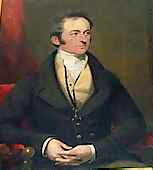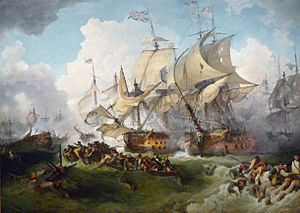George Dundas (Royal Navy officer) facts for kids
Quick facts for kids
George Dundas
|
|
|---|---|

George Heneage Lawrence Dundas
|
|
| Birth name | George Heneage Lawrence Dundas |
| Born | 8 September 1778 Upleatham, Yorkshire |
| Died | 7 October 1834 (aged 56) Upleatham, Yorkshire |
| Allegiance | |
| Service/ |
|
| Years of service | 1800–1834 |
| Rank | Rear Admiral |
| Commands held | First Naval Lord Comptroller of the Navy HMS Cameleon HMS Calpe HMS Quebec HMS Euryalus HMS Edinburgh |
| Battles/wars | French Revolutionary Wars War of the Fifth Coalition War of the Sixth Coalition |
| Awards | Companion of the Order of the Bath |
George Heneage Lawrence Dundas (born September 8, 1778 – died October 7, 1834) was an important officer in the Royal Navy. He became famous early in his career for being very brave. This happened during a big fire on a large ship called HMS Queen Charlotte.
Because of his bravery, he was given command of a smaller ship, HMS Calpe. With this ship, he fought in the Battle of Algeciras Bay in July 1801. This battle was part of the French Revolutionary Wars. Later, he became a Member of Parliament (MP) for Richmond. He was part of the Whig political party.
After four years in politics, he returned to the Navy. He commanded HMS Euryalus and took part in the Walcheren Campaign in July 1809. This was during the Napoleonic Wars. He then moved to HMS Edinburgh and helped land troops in Viareggio, Italy, in November 1812. He later became an MP again for Orkney and Shetland. In August 1834, he was made First Naval Lord, a very high position in the Navy. Sadly, he died just two months later.
Contents
George Dundas was born in 1778. He was the fifth son of Thomas Dundas, who later became Baron Dundas. His mother was Charlotte Dundas.
George joined the Royal Navy as a lieutenant in 1797. For several years, he served with the Mediterranean Fleet. This was a group of British warships in the Mediterranean Sea.
Brave Actions on HMS Queen Charlotte
In February 1800, Dundas was on HMS Queen Charlotte. This was a very large warship. On March 17, 1800, a fire broke out on the ship. Someone had accidentally set fire to hay stored below deck.
Dundas was in the front part of the ship. He quickly started organizing people to fight the fire. He led a group below deck to try and stop the fire from spreading. They closed hatches and opened sea cocks to flood the lower decks. This helped prevent the fire from reaching the gunpowder rooms.
Dundas kept working below deck even as parts of the ship started to collapse. Around 9 AM, he managed to escape to the forecastle (the front upper part of the ship). About 150 men were there, throwing water on the fire. Despite everyone's hard work, the Queen Charlotte exploded. Out of 840 people on board, 673 died. Luckily, Dundas survived this terrible event.
Commanding Ships: HMS Cameleon and HMS Calpe
After the fire, Dundas became captain of the sloop Cameleon in June 1800. A sloop was a smaller warship. His ship helped capture a Genoese (Italian) brig called Anima Purgatoria.
Next, Dundas was given command of HMS Calpe. This ship was originally a Spanish vessel captured by the British. Even though another officer, Francis Beaufort, had bravely captured the ship, Dundas was chosen to command it. He was promoted to commander in December 1800.
In July 1801, Dundas and Calpe fought in the Battle of Algeciras Bay. During the battle, a British ship, HMS Hannibal, got stuck. Dundas sent his boats to rescue its crew. However, the French captured his boats and their crews. Dundas and Calpe had to return to Gibraltar.
In a later part of the battle, two Spanish ships accidentally fired at each other. They caught fire and exploded, causing many deaths. The British captured a French ship called St Antoine. Dundas and Calpe helped secure this captured ship. Dundas was promoted to post-captain in August 1801. He then took command of St Antoine and sailed her back to England.
Life in Politics
After a peace treaty in 1802, Dundas decided to enter politics. He became a Member of Parliament (MP) for Richmond. He was a member of the Whig party. He served as an MP until February 1806. He then resigned to take up a naval command again. This also allowed his brother, Charles, to become an MP. In February 1805, he was given command of HMS Quebec.
Commanding HMS Euryalus
In January 1806, Dundas took command of HMS Euryalus. This was a fast warship called a frigate. Euryalus often escorted large groups of merchant ships (convoys) to places like Portugal and the Mediterranean.
In late 1807, Euryalus returned to England. It escorted a convoy of thousands of troops from Gibraltar. After some repairs, the ship was sent to the North Sea. It helped escort convoys through the Baltic Sea.
In June 1808, Dundas found several enemy ships near Nakskov. He sent boats to destroy them. They burned two large troop ships and captured a gun-vessel. The enemy lost many men, while the British had only one person slightly hurt. That same year, Dundas took members of the French royal family, including the future King Louis XVIII's wife, from Poland to Sweden, and then to England.
Dundas and Euryalus were also part of the Walcheren Campaign in July 1809. This was a British attack on the island of Walcheren. Euryalus helped force a passage through enemy defenses. The ship had no casualties during this action. Later, Euryalus captured a French privateer (a private ship allowed to attack enemy ships) called Etoile. In 1810, Euryalus escorted another large convoy and then joined a squadron off Toulon.
In early 1811, Dundas briefly commanded a larger ship, Achille. He then returned to Euryalus. In June 1811, boats from Euryalus and Swallow captured a French privateer called Intrepide near Corsica.
Dundas became an MP for Richmond again in 1812. However, he lost his seat in the general election later that year.
Commanding HMS Edinburgh
In October 1812, Dundas moved to command Edinburgh. This was a 74-gun ship, a powerful warship. In 1813, Dundas and Edinburgh were in the Mediterranean. On October 5, they joined other British ships to attack an enemy convoy near Porto D'Anzo. The area was protected by several batteries (gun placements).
During the attack, Edinburgh supported other ships as they fired at the enemy batteries. After the ships opened fire, landing parties went ashore. They captured 29 enemy vessels, many of which were carrying wood for a French naval base. The British also blew up all the enemy gun positions.
On November 30, 1812, Dundas led a small group of ships. They landed troops at Viareggio in Italy. About 600 enemy cavalry and infantry attacked the British troops. But the British fought them off, capturing two cannons. On December 13, British troops and Marines landed again. They occupied parts of the town. About 700 enemy cavalry and infantry attacked the Marines. The Marines fought bravely, causing many enemy casualties. Edinburgh had only three Marines wounded.
Later Life and High Office
When the war ended in 1815, Dundas left his ship and traveled back to Britain. He retired from the Navy that year. He was honored with the title of Companion of the Bath.
Dundas returned to politics. He won a seat as an MP for Orkney and Shetland in 1818. However, he lost in the 1820 election. He won the seat again in 1826 but was defeated in 1830. In 1830, he was also promoted to rear-admiral.
In November 1830, Dundas became Second Naval Lord in the government. This was a very important role in the Navy. In 1831, he was made a Deputy Lieutenant of York. On November 2, 1831, he became Comptroller of the Navy. This role involved managing the Navy's finances and supplies. This office was later combined with the Board of Admiralty in 1832.
In August 1834, George Dundas was promoted to First Naval Lord. This was the highest naval position in the government. Sadly, he died in office just two months later, on October 7, 1834. He died from a sudden illness called apoplexy at his home in Upleatham. He was never married. He is buried at Marske in North Yorkshire.



